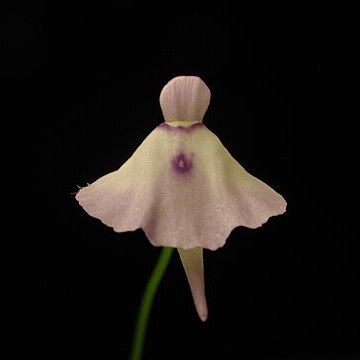Corolla white or pale lilac, 2–16 mm. long; superior lip 1.5–2 times as long as the upper calyx lobe, narrowly oblong with apex rounded, truncate or more or less emarginate; inferior lip circular, entire; palate much raised, double crested, the crests usually transversely tuberculate; spur usually conical-subulate, up to 4 times as long as the inferior lip but very variable in length and sometimes much reduced.
Inflorescence erect, 2–35 cm. high; peduncle filiform, straight, more or less setulose, papillose or rarely entirely glabrous; flowers 1–6(10), distant; scales few, similar to the bracts; bracts basisolute, shortly produced below the point of insertion, ovate, with apex acute, base truncate, more or less 1 mm. long, setulose; bracteoles similar to the bracts but narrower; pedicels erect, 0.5–2 mm. long.
Leaves usually present at anthesis, scattered on the stolons, circular, peltate, long-petiolate; lamina fleshy, mucilaginous, 1–5 mm. in diam.; petiole 2–10 mm. long.
Calyx lobes subequal, usually setulose; upper lobe ovate, 1.5–3 mm. long, with apex acute; lower lobe ovate or circular, with apex bidentate.
Traps numerous, globose, stalked, 0.5–0.8 mm. long, mouth terminal, with dorsal and ventral radiating rows of glandular hairs.
Ovary ovoid; style short but usually distinct; inferior lip of stigma semi-circular, superior much smaller, deltoid.
Capsule globose dehiscing by a longitudinal ventral slit with thickened margins.
Flowers white or mauve, very variable in size, calyx and scape often pubescent.
Rhizoids and stolons capillary, numerous from the base of the peduncle.
Seeds numerous, ovoid; testa-cells distinct, more or less isodiametric.
Filaments filiform; anther-thecae subdistinct.
Slender, few-flowered scape
Erect terrestrial herb
Small peltate leaves
Terrestrial herb.


